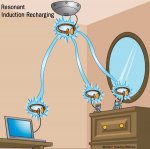Inductive coupling naturally is a very close proximity technique- it's amazing that even cordless toothbrushes charging is feasible- & long range "wireless power" is largely the stuff of science fiction & back yard tinkerers. Stealing even a few Watts from passing power lines is worthy Mythbusters material =>
http://www.youtube.com/watch?v=6hs9Gz4JuhI. The BBC mentioned a half baked 6.4MHz resonant approach some years back (
http://news.bbc.co.uk/2/hi/technology/6129460.stm ) that was thought capable of a few metres range. AFAIK it however went no further...
Very high freq. RF radiation beamed from any distance certainly can be received & collected with parabolic dishes, but the overall system merits are questionable. Although tempting to explore & ponder, especially with microwaves, such boring issues as safety may doom even simple investigations. "Powersat" satellite power plants, beaming from geostationary orbit (22,300 miles, 35,700 km), back to earth could be be received via enormous "rectenna" farms with good efficiency, but the overall cost and complexity is mind boggling.
Mmm- RFID ? RFID of course is a wireless technology & offers ranges to a few metres at usually ~13.56MHz, but it's intended for ID rather than power transfer. Aside from books, traffic tolls & retail items, innovative implants in golf balls, playing cards and even casino chips have arisen. Developments have been rapid in recent decades, & RFID "dust" has even been developed.
IMHO,although only a daytime resource, solar panels may be abundantly more appealing for a simple "wireless power" project. Panel efficiencies are only a mere ~10%, but the incident sunlight is free for the taking & PV prices are just an attractive US$5-$10 a Watt. Their availability & ease of use mean even a kid can safely investigate small scale photovoltaic sourced wireless power. Gloss up a project with mad scientist titles like
"Scavenged thermonuclear wireless energy transfer" plus lots of simple path loss calculations, & you'd really catch the audience. You may even score a governemnt grant!


